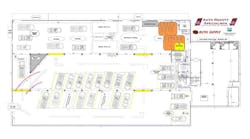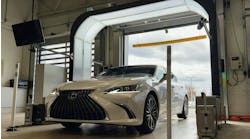Although this significant modification will affect the future of the collision business directly, it seems like many in the industry didn't notice. If this one slipped past you, now's the time to get up to speed. In late 2009, President Obama announced an aggressive mandate requiring all new cars and trucks achieve 35.5 miles per gallon by 2016 (an average of 39 mpg for cars and 30 mpg for trucks), cutting four years from the previous regulation timetable.
On the surface, what seems like a minor change could have a significant impact on vehicle construction in the short term, particularly wielding a great deal of potential to shape vehicle size in the long run. How? Compare the new rules for cars vs. light trucks, and you'll find the 2016 CAFE numbers represent about a 20-percent increase in economy for cars and 24 percent for light trucks. But CAFE standards aren't the only set of rules OEMs need to comply with.
The Environmental Protection Agency (EPA) also has its hands in the mix. It's critical to understand the difference between CAFE standards and the EPA average fuel-economy measurement. Both standards will compel automakers to put sales of fuel-efficient vehicles on the very top of their to-do lists, but in different ways. The two measurements, both calculated by the federal government, demonstrate one main differentiation.
Congress uses the harmonic mean (an average typically appropriate for situations in which the average of rates is desired) to calculate CAFE standards by capturing the fuel economy of a fleet by driving each car in the fleet for one mile.
The EPA, the government agency that writes and enforces regulations based on laws passed by Congress, uses the arithmetic mean (commonly referred to as the mean and defined as the mean obtained by adding several quantities together and dividing the sum by the number of quantities). The EPA's methodology captures the average mpg of the fleet by driving each car until one gallon of gas is burned (i.e. the 13-mpg vehicle would be driven for 13 miles, while the 100-mpg vehicle would be driven for 100 miles).
Why do we care how bureaucrats arrive at their sums? The bottom line to the EPA's calculation is extremely high-mileage vehicles, such as the Chevrolet Volt or Nissan Leaf, will have a smaller impact on fleet economy. One or two vehicles that get poor economy, such as a full-size SUV or a high-performance car, can consume enough fuel to require the automakers to sell a lot full of 40-plus mpg cars to compensate.
Sound complicated? It is, and that's just the beginning. Because the government wants to encourage the use of alternative fuels, such as E85, there are credits that relax mileage standards for automakers if they have a large number of E85-capable vehicles. Additionally, like many pollution standards, automakers can borrow CAFE credits for three years if they can't make the numbers in any single year.
Despite this ability to game the fuel standard, the fact remains moving the mileage deadline up four years will force automakers to step up the amount of lighter body components, exotic metals and adhesive bonding structures to slim down existing vehicle architecture and save weight. An easier way to translate this is to remember the auto industry rule of thumb regarding weight and fuel savings that implies a vehicle can gain 2 to 3 percent fuel economy for every 220 pounds in weight reduction.
Automakers will start their diets with bolt-on panels. It's possible the hood panel on a 2012 model year car will be mild steel, and in a few years that identical model will use an aluminum or exotic alloy hood on the 2016 model to slim down even more for the new fuel standards.
You'll see modifications on the subframe structure too, such as BMW's injection-molded plastic transmission cross-beam member by BASF on its new 5 Series Gran Turismo 550i. Choosing BASF's Ultramid A3WG10 CR injection molded plastic instead of aluminum allows a 50 percent or 2.2 pounds (1 kilogram) reduction in the part's weight. Compared to the same component made of metal, this is a milestone in lightweight car construction, which is significant since automakers are extremely focused on optimizing vehicle acoustics and crash safety.
They've got their hands full. Imagine the development costs required to produce this high-tech part, all to save 2.2 pounds in the name of better fuel economy. Auto manufacturers understand trimming down their vehicles' fat won't entirely put them on par with the stringent new standards, so they're exploring other avenues.
Automakers are looking at importing smaller, more fuel-efficient cars from Europe and Asia to ensure their offerings meet the new 2016 requirements. Why import? Europe and Asia have a relatively new, popular, pocket-sized class referred to globally as the "B-segment" that can fill the immediate need. We're just starting to see uber minis such as BWM's Mini and Ford's newly launched Fiesta in the U.S., but get ready to see more as major players in Detroit make good on implementing aggressive plans to increase the number of imports or build many more in North American plants.
Chrysler announced its intention to import the Fiat 500, a car slightly smaller than but equally sporty as the Mini. Chevrolet will introduce the Cruze, a car positioned in between the compact Cobalt and the tinier subcompact Aveo, and likely will continue to produce the Cobalt in fewer models as a "decontented" model that'll become a discounted offering while it moves the Cruze up market.
For the largest automakers, producing a world architecture B-segment car has its cost advantages, such as saving on development costs and ordering much larger lots from global subcontractors to save on content costs. These savings have been a goal of the largest automakers for decades, but different regulations have hampered past efforts.
As far back as 1981, Ford proclaimed its Escort as a world architecture car when in reality engines, transmissions, interiors and lights differed vastly to meet country-specific regulations and customer tastes. Before the European Union, even European spec meant exterior mirrors, side-marker lights and turn-signal lenses had to be different colors or of varying specifications. If you parked a European Ford Escort next to its American cousin, you could see a family resemblance. But the American version featured rectangular-sealed beam headlamps and 5-mph bumpers that hung awkwardly from the black accordion bumper to body fillers. The European version featured much more appealing aerodynamic flush halogen lamps with body-hugging plastic bumper covers. Under the hood, the cars offered varying power plants for differing fuel economy needs and alternate transmission gearing to allow more comfortable driving for respective speed limits.
These new B-segment cars will be small and relatively inexpensive but will still be required to come equipped with standard safety features, such as ESC and side-impact airbags, which will dramatically increase their likelihood of totaling out, even in moderate collisions.
Some B-segments will be loaded with creature comforts and expensive trim options to attract upscale buyers to this burgeoning smaller segment. The most extreme example is the Aston Martin Cygnet. Built using the Toyota iQ as a base, this two-seat, 997cc microcar is slightly larger than Daimler's smart car, but it packs a luxurious interior in true Aston Martin tradition. This creature of necessity came about so automakers like Aston Martin could balance their new car portfolios and satisfy the European Union's corporate carbon footprint regulation.
Aston Martin announced prices in the $45,000 range for the Cygnet. Will it sell? I suppose prospective buyers will have to weigh the novelty of saying to friends, "I just bought a new Aston Martin," with the reaction of uncontrolled laughter when those friends first see the car.
How will this affect collision repairers? Technicians will need to properly identify the metallurgy of the panel materials before beginning the repair. In terms of volume, you might see an influx of base model B-segment cars towed into your shop, but if they were hit hard enough to be nondrivable, they'll likely end up as totals.
That said, there may be some higher end B-segments where there will be more room to repair, the mix of which will be left up to consumer tastes. If the Cygnet becomes a hit, it might be time to make friends with your local Aston Martin dealer.


